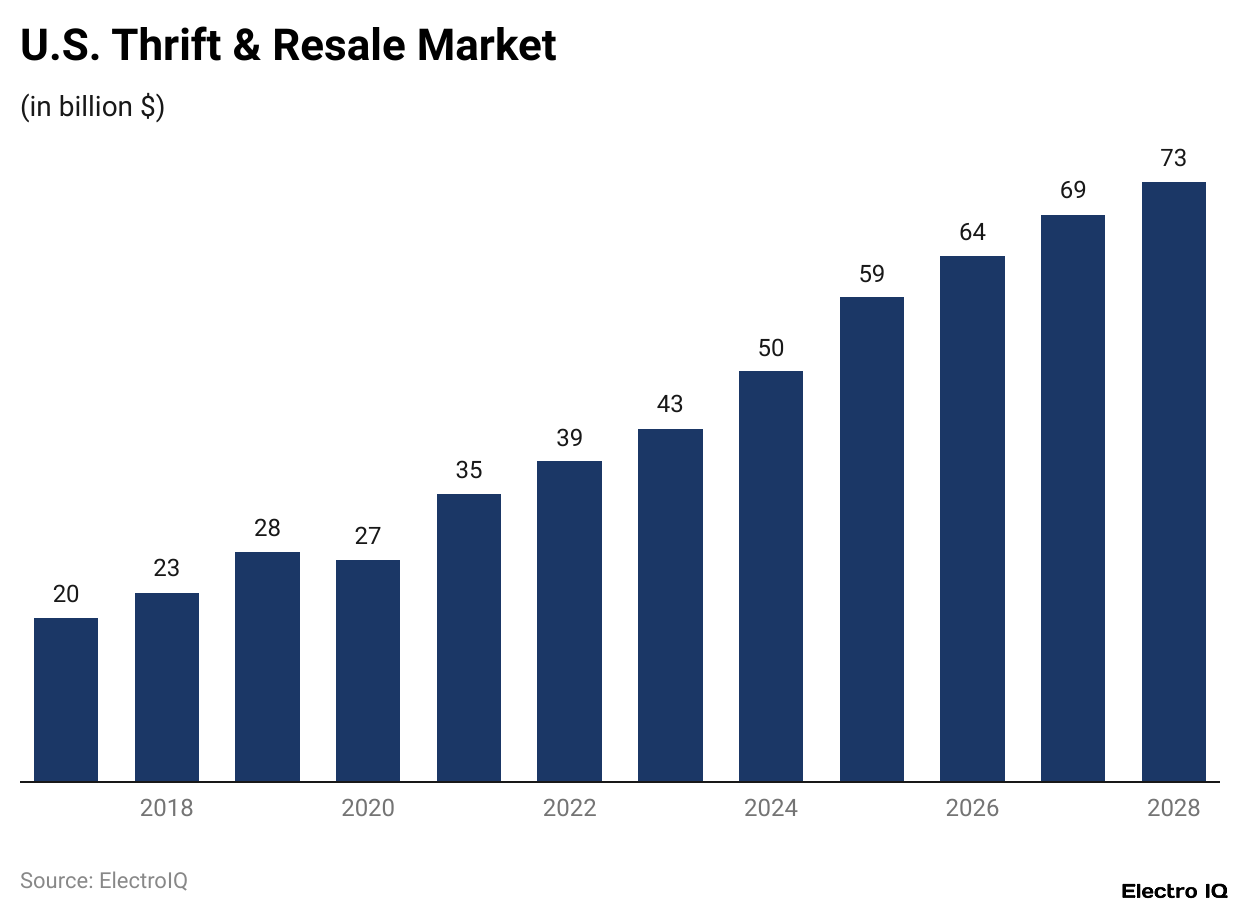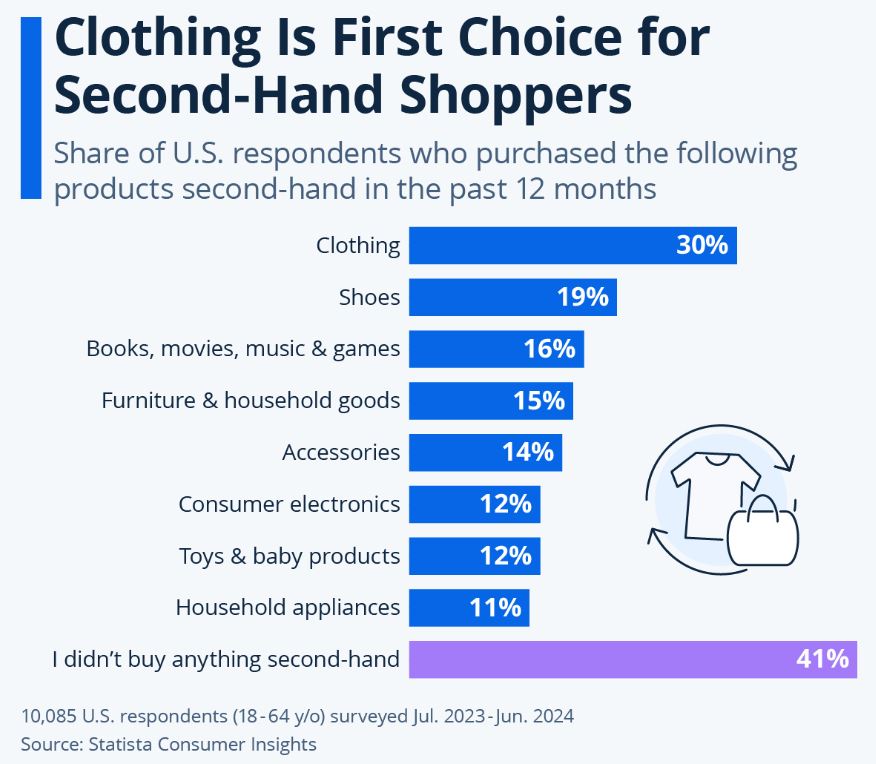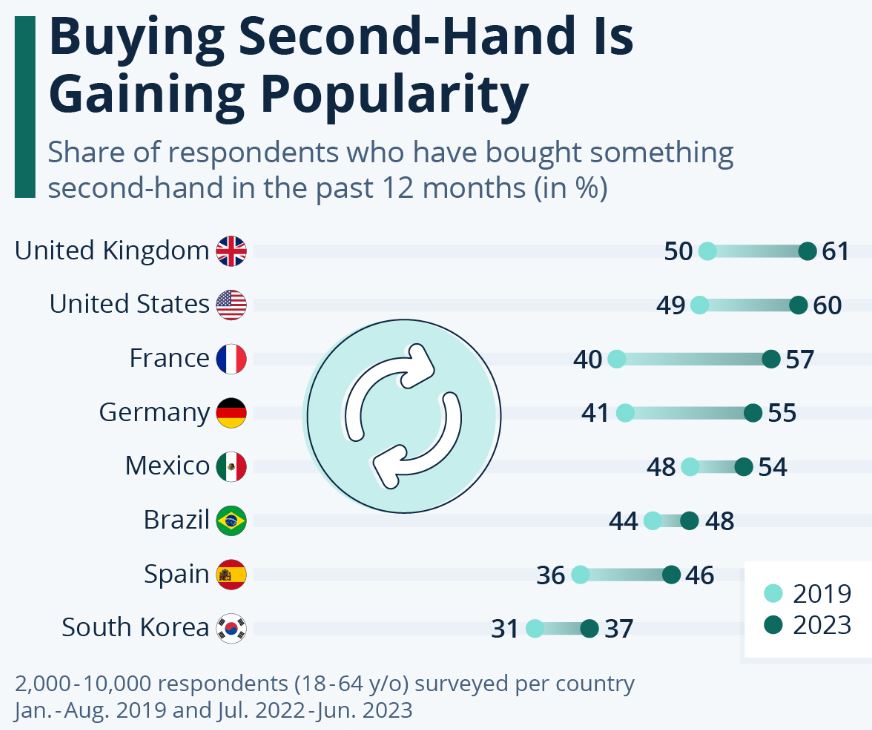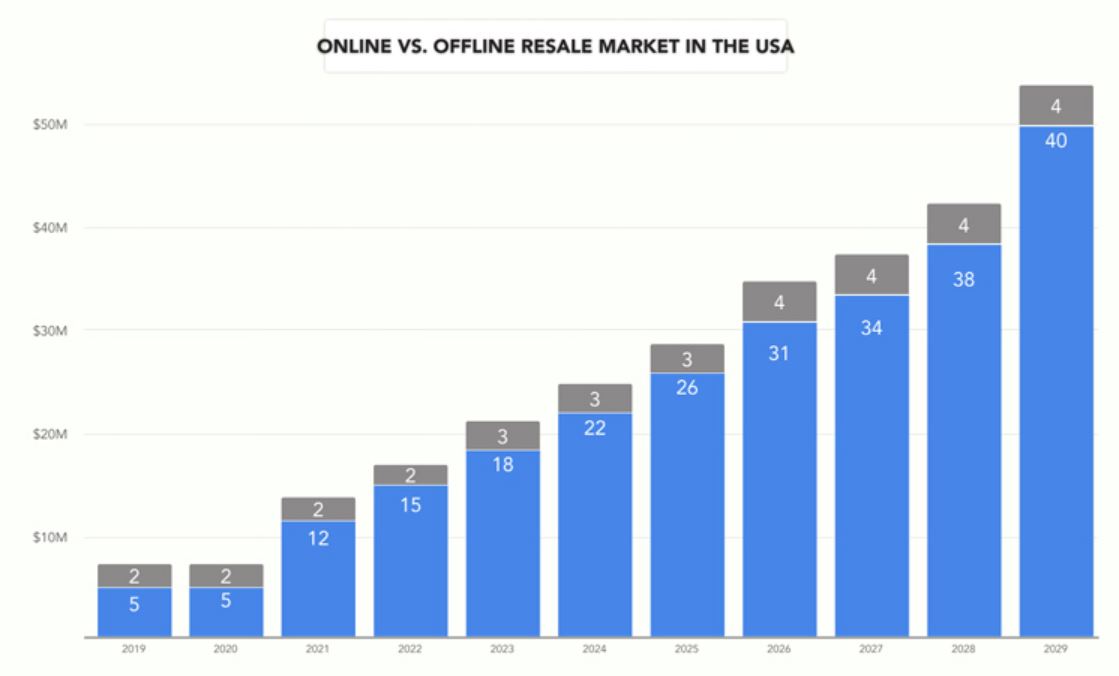Thrifting Statistics By Market, Consumer, Shoppers And Facts (2025)
Updated · Jun 25, 2025

Table of Contents
- Introduction
- Editor’s Choice
- General Thrifting Statistics
- Thrifting Market Statistics
- Thrifting Consumer Statistics
- Time Spent In Thrift Stores Statistics
- Thrift Store Industry Statistics
- Thrift Stores Statistics By Country
- Thrift Shoppers Statistics
- Reasons For Using Thrift Products Statistics
- Gift Thrifting Statistics
- Thrifting Statistics By Environmental Impacts
- Thrifting Popularity Statistics By Country
- Online vs. Offline Thrift Market In The U.S.
- Thrifting Employee Statistics
- Pros And Cons of Thrifting
- Conclusion
Introduction
Thrifting Statistics: Thrifting is the act of shopping for used, pre-owned, or vintage items, basically at thrift stores, flea markets, or via online platforms. From branded clothing to affordable furniture and electronics, people of all ages are turning to secondhand shopping for its value, uniqueness, and environmental benefits. As concerns about fast fashion and waste grow, thrifting offers a smart and sustainable way to shop.
This article presents several statistical and current analyses from different perspectives, including how the thrift industry has evolved, what drives its growth, and why more consumers are opting for secondhand goods over new ones.
Editor’s Choice
- According to Capital One Shopping Research reports, approximately 93% of Americans utilise online platforms for purchasing secondhand products.
- The global thrift market is expected to secure around USD 264 billion in revenue by the end of 2025.
- Meanwhile, in the United States, it is expected to reach around USD 59 billion during the same period.
- More than 25,000 shops selling resale products are available in the U.S.
- By purchasing secondhand products annually, thrift store shoppers have saved an average of USD 1,760.
- As of 2024, in the U.S., almost 1/3rd of clothing and apparel items were purchased via thrift stores.
- Out of the total secondhand market, about USD 24 billion (48%) comes from traditional thrift stores and donations.
- The other USD 26 billion (52%) comes from resale platforms.
- Overall, secondhand clothing makes up more than 9% of all clothing sales in the U.S.
- As of 2024, the United States had more than 28,849 thrift stores available.
General Thrifting Statistics
- Every year, National Thrift Store Day is celebrated on August 17.
- Meanwhile, thrift stores are projected to grow at a slower rate, with an expected range of 3.7% to 8.3% from 2024 to 2027.
- The GrabOn report states that around 30% of Gen Z buyers choose secondhand items to afford more expensive brands.
- Approximately 66% of thrift shoppers believe that buying secondhand is more environmentally friendly than purchasing new products.
- Approximately 16% to 18% of American people report shopping at thrift stores.
- When it comes to secondhand fashion, 45% of Gen Z and Millennials prefer online shopping, while 38% like going to physical stores.
- Two out of every five clothing items bought in the past year were secondhand.
- Thrift store shoppers typically save around USD 150 per month.
- On average, secondhand shoppers save approximately USD 1,760 per year by opting not to buy new.
Thrifting Market Statistics
- As of 2025, Americans’ online Thrift spending per user is estimated to reach around USD 788.38, up from USD 665.44 in 2024.
- In 2024, U.S. fashion resale platforms generated USD 16.8 billion in sales, representing an 18.5% increase from 2023.
- Resale accounts for 7.4% of all apparel e-commerce sales in the U.S.
- By 2026, online apparel resale sales are projected to reach USD 23.9 billion, accounting for 8.4% of the global fashion e-commerce market.

(Reference: imagedelivery.net)
- The graph above indicates that the global thrift market is expected to generate approximately USD 264 billion in revenue by the end of 2025.
- The estimated projections in 2026 will reach USD 295 billion, followed by 2027 (USD 324 billion), and 2028 (USD 350 billion).

(Reference: imagedelivery.net)
- Additionally, in the United States, the expected revenue secured by the Thrift market is projected to reach around USD 59 billion, up from USD 50 billion in 2024.
- In the coming years, the market is expected to reach USD 64 billion in 2026, followed by USD 69 billion in 2027 and USD 73 billion in 2028.
Thrifting Consumer Statistics
- In the next 5 years, 83% of Gen Z consumers have either purchased or are interested in secondhand apparel, 10.7% more than the average for all age groups.
- In contrast, women accounted for a high share of secondhand apparel shoppers, comprising 55.7% of the U.S. market, while men accounted for 44.3%.

(Reference: imagedelivery.net)
- The above pie chart states that the highest American thrifters are aged from 25 to 34 years, capturing a share of 29.7%, followed by 35 to 44 years (23.8%).
- Furthermore, other thrifters share by age are followed by 18 to 24 years (18.1%), 45 to 54 years (16.6%), and 55 to 64 years (11.8%).
Time Spent In Thrift Stores Statistics
- As of 2024, thrift store shoppers usually spend between 30 minutes and 1 hour.
- About 29% stay for 1 to 2 hours, and 8% shop for over 2 hours and only 13% of thrifters complete their shopping in under 30 minutes.
Segmentation by generation is detailed below:
| Generation | <30 minutes | 30 minutes to 1 hour | 1 to 2 hours | 2+ hours |
| GenZ | 7% | 47% | 35% | 11% |
| Millennials | 9% | 46% | 35% | 10% |
| GenX | 14% | 51% | 29% | 6% |
| Boomers | 22% | 54% | 21% | 3% |
Thrift Store Industry Statistics

(Source: businessdasher.com)
- As of 2024, the United States had more than 28,849 thrift stores available.
- The average revenue of a thrift store in the United States is around USD 300,000.
- By the end of 2027, the thrift industry is expected to outpace the broader retail clothing sector by 9 times.
- Out of three, two retailers plan to boost their thrift store investments in the coming years.
- Meanwhile, 82% of retailers state that thrifting will bring positive investment returns.
- Capital One Shopping Research reports indicate that in 2023, the U.S. thrift market for apparel resale accounted for USD 53 billion.
- Meanwhile, the second-hand e-commerce market accounted for USD 38.5 billion.
- Whereas, secondhand furniture sales totalled USD 38 billion during the same period.
- As of 2022, the market for thrifted furniture and mattresses was valued at USD 21.2 billion.
- Research Nester further predicts that by the end of 2025, the refurbished appliance market will reach more than USD 57.99 billion and is expected to grow to USD 195.91 billion by 2037, with a compound annual growth rate (CAGR) of 10.5%.
- According to the Global News Wire’s 2023 report, the second-hand electronic products market generated USD 93.7 billion in revenue, and by 2034, it will reach USD 434.4 billion, with a CAGR of 15%.
By Market Size And Growth Rate
- According to Step by Step Business, the thrift store industry in the U.S. is worth nearly USD 11 billion, with an average annual growth rate of 1% over the last five years.
- ThredUp, a well-known resale company, reports that the U.S. resale market is currently valued at USD 35 billion and is expected to more than double to USD 82 billion.
- In the United States, there were more than 26,000 thrift stores in 2024.
Thrift Stores Statistics By Country

(Source: grabon.com)
- According to a Fashion United report, the United States has approximately 28,849 thrift stores, while around 93% of people in the United States shop for secondhand items online.
Furthermore, the total number of thrift stores in other countries is mentioned in the table below:
| Country | Number of stores |
| Japan | 483,000 |
| United Kingdom | 4,082 |
| Netherlands | 4,326 |
| Sweden | 2,097 |
| Germany | 11,600 |
| Canada | 2,823 |
| Belgium | 2,263 |
| Austria | 1,000 |
| Denmark | 250 run by the Red Cross,
114 by DanChurchAid, 55 by Blue Cross |
| Australia | 335 |
| South Korea | 100+ |
Thrift Shoppers Statistics

(Source: statista.com)
- The above graph indicates that clothing is the top item thrift shoppers seek, with 30% of Americans purchasing secondhand clothing items between July 2023 and June 2024.
- In the same period, other shares of U.S. respondents those purchased second hand products are 19% (shoes), 16% (books, movies, music and games), 15% (furniture and household goods), 14%(accessories), 12% (consumer electronics), Toys and baby products (12%), and household appliances (11%).
- In contrast, 41% of them claimed they didn’t buy anything second-hand.
Reasons For Using Thrift Products Statistics
- The primary reason Americans shop at thrift stores is to save money, with 85% of shoppers citing this as their top motivation.
Others are elaborated in the table below:
| Usage Reason | American share |
| Help the environment | 42% |
| Discounted high-end brands | 40% |
| hunt for unique clothes or costumes | 33% |
| fun and excitement | 32% |
| affordable furniture | 30% |
| Thrifting is simply cool | 27% |
| Follow fashion trends | 20% |
| General affordability | 17% |
| To support local communities | 17% |
| To resell items for profit | 13% |
Gift Thrifting Statistics

(Reference: imagedelivery.net)
- The top reason shoppers consider gifting secondhand items is saving money at a rate of 56%.
- Moreover, 54% of thrift gift shoppers choose secondhand items to be more sustainable, while 34% prefer originality.
Thrifting Statistics By Environmental Impacts
- Capital One Shopping Research states that, on average, carbon emissions can be reduced by 25% by buying used clothes instead of new ones.
- Users can save approximately 8.4 pounds of carbon emissions, 16.5 kilowatt-hours of energy, and around 89 gallons of water by opting for a secondhand outfit.
- Every year, approximately 11.3 million tons of clothing waste end up in landfills in the United States, accounting for 7.7% of global landfill waste.
- Out of the 17 million tons of textile waste produced annually, only about 14.7% gets recycled.
Thrifting Popularity Statistics By Country

(Reference: statista.com)
- The above Statista report states that in the United Kingdom, 61% of respondents reported making at least one second-hand purchase in 2023, up from 50% in 2019.
- Similarly, in 2023, the share of popularity of buying second-hand in other countries is the United States (60%), France (57%), Germany (55%), Mexico (54%), Brazil (48%), Spain (46%), and South Korea (37%).
Online vs. Offline Thrift Market In The U.S.

(Reference: grabon.com)
- The above graph indicates that the online resale market in the U.S. is expected to reach USD 26 billion, while the offline resale market is projected to reach USD 3 billion by the end of 2025.
Besides, the estimated resale market size in the U.S. is detailed below:
| Year | Online resale (USD billion) |
Offline resale (USD billion) |
| 2026 | 31 | 4 |
| 2027 | 34 | 4 |
| 2028 | 38 | 4 |
| 2029 | 40 | 4 |
Thrifting Employee Statistics
- Step by Step Business shows that approximately 140,000 people were working in the thrift market across the country.
- Male employees’ shares in Thrift stores accounted for the largest share, at 72%, followed by female employees at 28%.
- The average age of thrift employees is around 39 years.
- Meanwhile, the average level of education of a thrifty employee is a bachelor’s degree.
Pros And Cons of Thrifting
| Pros | Cons |
|
Save items from landfills and provide them at affordable prices. People can start a thrift store as an online business. Resale items are in high demand. |
The costs associated with opening a physical location are high. Required to find merchandise as well as sell it. |
Conclusion
After completing the article on Thrifting Statistics, it can be concluded that the overall thrifting market has grown far beyond its budget-friendly factor, and it’s now termed a powerful movement driven by sustainability, style, and smart consumer habits. Thousands of people choose to purchase second-hand items each year, and thrift stores and resale platforms are reshaping our perspective on fashion, furniture, and everyday goods.
As the industry continues to expand globally, thrifting not only helps reduce waste and save money but also promotes a more conscious and creative way to shop. Whether online or in-store, thrifting is here to stay. All the above analyses will help you gain a better understanding of the topic.
Sources
FAQ.
Thrifting is more than a trend but a shift toward sustainability, affordability, and conscious consumer choices across all ages.
The best time for thrifting is early in the morning on weekdays, specifically on Mondays.
Yes, due to its low prices, unique finds, sustainability, creativity, and the thrill of discovering hidden treasure, some people do enjoy thrifting.
Thrifting risks include poor item quality, hidden damage, hygiene issues, limited sizes, counterfeit goods, and inconsistent return policies.
Avoid buying items regularly, damaged goods, poor fits, missing tags, and ignoring return policies or hygiene guidelines.

Joseph D'Souza founded ElectroIQ in 2010 as a personal project to share his insights and experiences with tech gadgets. Over time, it has grown into a well-regarded tech blog, known for its in-depth technology trends, smartphone reviews and app-related statistics.









